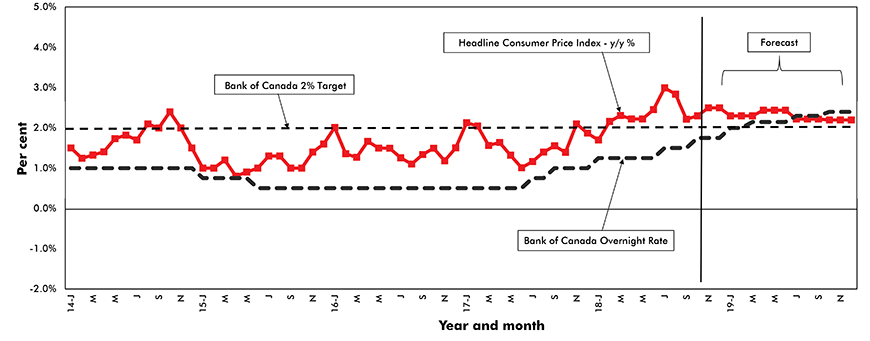As many expected, including ourselves in the Snapshot titled “No Short Term Fix Likely For Housing Affordability in Vancouver or Toronto”, the Bank of Canada raised its target for the overnight rate by 25 basis points to 1.75% on October 24.
This is its highest level since November of 2008. Based on recent remarks by Bank of Canada governor, Stephen Poloz, and on several other economic indicators which the Bank uses to guide monetary policy, this is not the last time the Bank plans to raise interest rates.
Probably the most significant indicators foreshadowing higher interest rates are the several measures of inflation which the Bank uses to formulate monetary policy.
Topping the list is the headline inflation rate which at 2.2% has been above the Bank’s 2% target since January of this year. In an effort to see through short-term fluctuations in the headline inflation rate, the Bank looks at three measures of core inflation: CPI trim; CPI-median; and CPI-common. All of these measures have been within 0.1 percentage points of 2% since January.
In addition to direct measures of inflation indicated by year-over-year changes in prices, the Bank monitors indicators of inflationary pressure such as industrial capacity utilization rates and the amount of slack in the labour market indicated by the unemployment rate.
Fuelled by strong gains in resources production (mainly oil and gas production) and a rebound in manufacturing output, industrial capacity utilization in Canada jumped 2.2% to 85.5% in the second quarter to its highest level since the third quarter of 2007.
This increase has been accompanied by strong growth of employment that has caused Canada’s unemployment rate (currently at 5.8%) to remain at or below 6% for an unprecedented 12 months.
The Bank’s most recent Business Outlook Survey (BOS) reinforces the view that the Bank will continue to gradually raise its policy interest rate in the near term. First, a solid majority of firms polled by the Bank expect economic conditions to continue to improve over the next twelve months, driven by strong U.S. growth. Second, investment intentions rebounded in the third quarter to their second highest level since Q3/2010.
Consistent with the high level of industrial capacity utilization, the BOS indicated that the percentage of firms reporting that they would have difficulty meeting an unexpected increase in demand remained near an eleven-year high largely due to shortages of skilled workers.
Indeed, in the third quarter, almost 50% of firms surveyed experienced more acute labour shortages. Regarding inflationary expectations, the BOS reported that 62% of respondents expected inflation to exceed 2% over the next two years.
Probably the most compelling reasons to expect the Bank to raise interest rates higher in the near term are recent comments by Bank of Canada Governor Poloz before the House of Commons Standing Committee on Finance.
The governor stated that “even with the latest (October 24) increase in the policy rate to 1.75 per cent, monetary policy remains stimulative”.
This observation is reinforced by the governor’s observation that even after the 25 basis-point increase, “after adjusting for inflation, the policy rate is still negative”.
Currently, the Bank estimates that in order to achieve its 2% inflation target it must raise the policy rate to 3% plus or minus half a percent.
Although there is plenty of evidence pointing to higher interest rates, the big questions of “When do they rise?” and “By how much?” are unanswered. Governor Poloz is vague about the timing of further rate hikes noting that the Bank will “take into account how the economy is adjusting to higher interest rates, given the elevated level of household debt”.
However, the economists at Canada’s big five banks are less hesitant to express their views about the near term interest rate outlook. While all five banks expect the Bank of Canada’s overnight target rate to rise from its current 1.75% level to 2% by the end of Q1/2019, their views diverge over the course of the year.
The Bank of Nova Scotia, the most bearish of the forecasters, expects the policy rate to trend steadily higher reaching 2.75% by the end 2019. CIBC is considerably less bearish expecting interest rates to remain at 2% through the remainder of 2019 and throughout 2020.
Calculating a consensus interest rate forecast by averaging the forecasts of the five banks, the policy rate average moves from its current 1.75% to just under 2.5% by the end of next year.
Headline Inflation vs Bank of Canada Overnight Rate

Chart: ConstructConnect — CanaData.











Recent Comments
comments for this post are closed